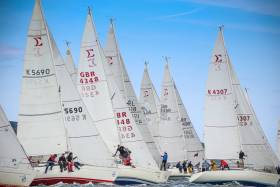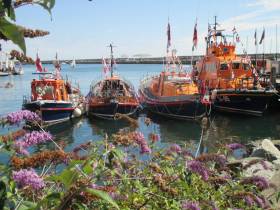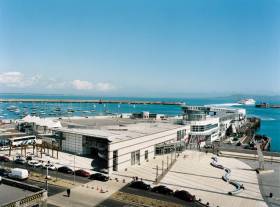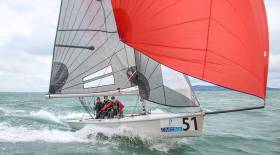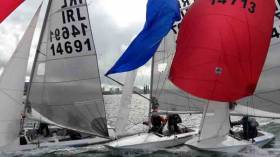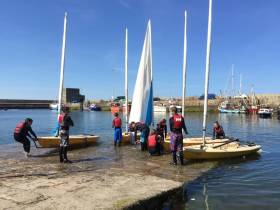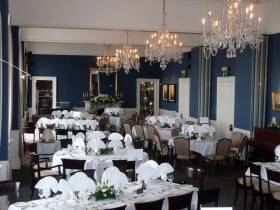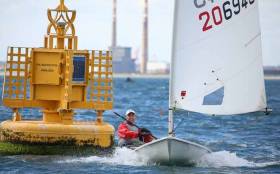Displaying items by tag: Dun Laoghaire
Are you Interested in Sailing or Buying a Sigma 33?
Are you Interested in Sailing or Buying a Sigma 33?
Experience a sail at our Open Morning on Sunday, 24th September 2017 at the Royal St. George Yacht Club
from 9.30–1.00 O’Clock
Followed by finger food in the Club afterwards
For more details call Paddy Maguire 087 2361916 or e- mail [email protected]
More details on the Sigma 33 class from the 2017 season below.
The Volvo Dun Laoghaire Regatta was for the Sigma 33 one design class the third major open Championship of 2017. The season stared in Tarbert, Scotland at the end of May, with the Scottish series with ten competitors and was won by “Mayrise” James Miller of Cove Sailing Club (CCC) with four wins from eight races.
The next event was in Helensburgh in Mid-June for the Class Championships which was won by “ Miss Behavin” Alan Lennox, Helensburgh Sailing Club. The 13–boat fleet completed eight of the ten planned races over the three days.
The Dun Laoghaire Regatta series had 19 entries including nine from the home waters and ten visitors from Northern Ireland, Scotland, England, the Isle of Man and local boats from Arklow and Waterford. The nine race series was dominated the top six visiting boats. Most of them had competed in Tarbert and Helensburgh and benefited from the close racing at both events. It proved very difficult for local boats to break into the top six in any race. The racing was very competitive with places changing on all legs. The Dun Laoghaire Regatta series was won by Alan Harper & Kristy Robertson in “ Mayraise” The Irish Championship were run in conjunction with the regatta and won by Paul Prentice in “ Squawk” from the Royal Ulster Yacht Club.
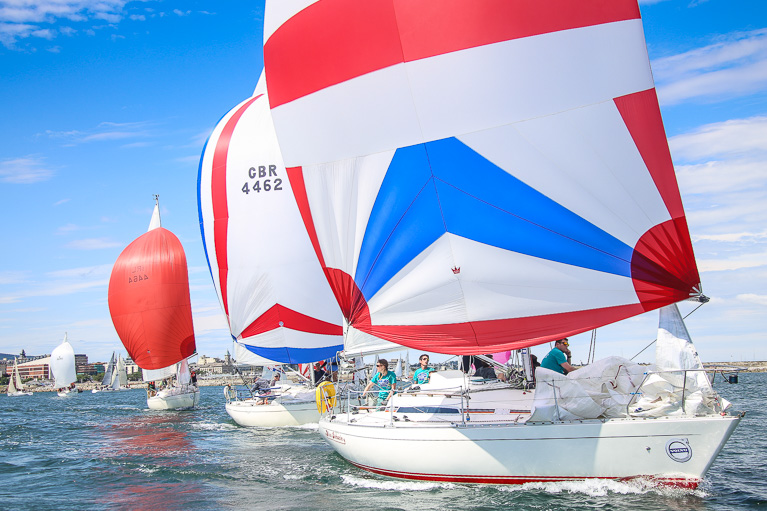 Visiting Sigma 33 crews to Dublin Bay in July visiting crews were made up of young and experienced sailors, both men and women. Photo: Afloat.ie
Visiting Sigma 33 crews to Dublin Bay in July visiting crews were made up of young and experienced sailors, both men and women. Photo: Afloat.ie
The Sigma 33’s were the biggest one design keelboat class at the regatta and this added to the more enjoyable competition for competitors. The visiting crews comprised young and experienced sailors, both men and women. It’s on occasions like that that you think of how good Tim Goodbody was in that he was regularly in the top three in such regattas.
It wasn’t all racing and on the Friday night 120 of the fleet held a bicentennial Dinner in The Royal Irish Yacht Club. Prizes were presented to the winners of the day’s racing “ Mayrise” Alan Harper and Kristy Robertson CCC and “Rupert” Richard and Philip Lovegrove of the RStGYC. Thanks to Dun Laoghaire Harbour Company, each boat was presented with a History of the Harbour.
The local fleet will recognise that they need to be more competitive as a fleet if they are to compete more successfully in this type of competitive regatta. There is a big incentive for the Class. In 2018, the Sigma 33 National Championships and Irish Championships will be held in Dun Laoghaire and 2019 is a Dun Laoghaire Regatta year. It is expected that similar entries to 2017 will compete each year. This also provides a great opportunity for young local sailors to acquire a Sigma 33 with a major event in local waters for each of the next two years and discover how successfully they could compete against the visitors and local sailors.
 The Sigma 33 Fleet will hold a 'Sigma 33 Morning' on Sunday 24th September 2017 at 9.30am in The Royal St. George in Dun Laoghaire
The Sigma 33 Fleet will hold a 'Sigma 33 Morning' on Sunday 24th September 2017 at 9.30am in The Royal St. George in Dun Laoghaire
As part of the recognition of the changes required to improve our competitiveness, the Sigma 33 Fleet will hold a 'Sigma 33 Morning' to enable anyone interested in buying or sailing on Sigma 33’s to sail on Sunday 24th September 2017 at 9.30am in The George. All are welcome to come down and to join us for finger food afterwards. If you wish to attend please confirm your attendance by contacting Sigma 33 Class Captain Paddy Maguire at [email protected]
Vintage Lifeboat Visit to Dun Laoghaire RNLI Highlights Lifesaving on Dublin Bay Since 1803
In this bicentenary year of Dun Laoghaire harbour, the visit from three vintage lifeboats to Dun Laoghaire at the weekend served to highlight the RNLI's contribution to lifesaving from Dun Laoghaire Harbour since 1861 and also to celebrate the lifeboat stations annual Open Day.
There has been an unbroken record of lifeboats launching on service since 1803 when the first was stationed at Sandycove harbour on Dublin Bay.
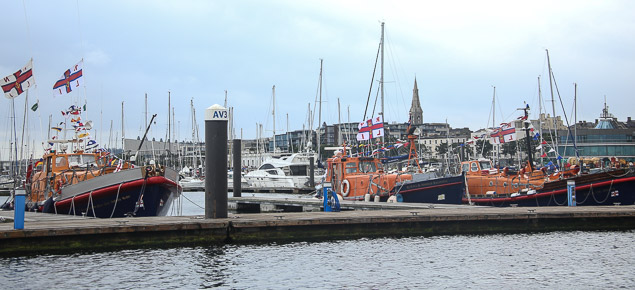 The vintage lifeboats at Dun Laoghaire Marina
The vintage lifeboats at Dun Laoghaire Marina
#BottomsUp - In a follow-up to Square Sail, the film production operator of Phoenix that called to Dun Laoghaire for repairs was made all the more intriguing given as to where the brig berthed, writes Jehan Ashmore.
The 34m long two-masted Phoenix which has made numerous film and TV screen credits, among them as a privateer in the TV series ‘Frenchman’s Creek’ set in Cornwall is also where Square Sail are based. The call to Dun Laoghaire of the almost 80 gross tonnage brig led to a berth most unusally located in the harbour's innermost Old Harbour.
The particular berth in front of the Irish National Sailing School (INSS) was almost tucked into the corner of where the harbourside road leads up to the foot of the West Pier. As for the reason of the call to the INSS as previously reported on Afloat was because the Phoenix required repairs to the hull's ‘bottom’ timbers.
Previously, Phoenix participated at the Dublin Riverfest on the Liffey last weekend. The work at neighbouring Dun Laoghaire was chosen because of the tides that allowed the brig drawing 2.6m to settle on the muddy bottom within the harbour. Such an exercise could not have taken place on the Liffey nor at the capital's last dry-dock having recently closed.
This alternative 'open' dry-docking involved the hull of the Phoenix to lean against the quay wall of the West Pier. As pictured above at low tide is a boat and personnal alongside the bottom timbers.
The 1929 Danish built schooner now brig has a rig based from the period 1760. The year is somewhat apt as the Old Harbour’s Pier was constructed in 1767. Those in the clubhouse of the nearby Dun Laoghaire Motor Yacht Club (DMYC) have elavated views across this harbour to the pier that this year celebrates its 250th anniversary.
Well that’s something new to learn of and all thanks to the Dun Laoghaire Harbour Company’s Walks Map, for a PDF download click here. So do get out and enjoy celebrating the magnificence of the harbour both old and the new!... in this Bicentenary year.
For those taking a stroll along the West Pier, driving past on related road and of the DART line parallel, the sight of a tallship Phoenix was no doubt a surprise to many.
Otherwise the scene here is normally of yachts belonging to the DMYC and a plethora of small sailing craft rafted together from the INSS. As previously reported the INSS had a relationship 20 years ago with Square Sail during the making of D–Day beach scenes for the film 'Saving Private Ryan' at Curracloe Beach, Wexford.
The last relatively large vessel in the Old Harbour based from personal recollection was an abandoned trawler that had lain for years. The trawler was at the far corner next to the public slipway. Adjoining this amenity is now an area for car-parking that encroached into the harbour, however it is useful for small leisure craft activity.
Work to repair Phoenix was completed yesterday and with that the tallship departed last night. This involved passing the outer Coal Harbour with its Traders Wharf. At the end of this pier is the popular Fish Shop along with eager seals always on the look out for a free meal!
Beyond the shop within the former BIM ice-plant facility are the marina breakwaters that lead out into the open expanse of the harbour. Having passed the commanding yet graceful West and East pierheads the brig headed into Dublin Bay to anchor last night.
Twelve hours later Phoenix and her crew set off this morning bound for Drogheda.
The Co Louth port is to welcome tommorrow morning Phoenix as part of 'Parade of Sail' when heading up the Boyne. This in advance of the weekend’s wonderful gathering of tallships at the Irish Maritime Festival, for much more click here.
Ferry Terminal in Dún Laoghaire May Become Tech-Centre
#FerryTerminal - A change of use through a planning application of the former ferry terminal in Dún Laoghaire Harbour, from duty-free shops and passenger services to a 450-job technology cluster, is to be lodged in coming weeks.
The move writes The Irish Times comes as Dún Laoghaire Harbour Company is in advanced negotiations with a preferred bidder for a multimillion euro, 10-year lease on the building.
The plan to redesignate the terminal is an attempt to generate an income from the building, which was opened 22 years ago to facilitate Stena’s Dún Laoghaire-Holyhead ferry service, which was subsequently withdrawn
The Harbour Company is also selling a small parcel of land known as “the gut” at the base of the west pier. Both moves are designed to generate income to meet the harbour company’s core objective of maintaining the harbour itself. Last year the Harbour Company spent €1 million on repairs to the Carlisle Pier and further repairs are needed to the west pier.
Confirming the negotiations on the lease and change of use of the former ferry terminal at St Michael’s Pier, Gerry Dunne, chief executive of the harbour company, said a public tender process had identified a preferred bidder for a 10-year lease on the building.
The newspaper has more on the story, click here.
#VolvoRegatta - Do you or someone you are sailing with in this summer’s Volvo Dun Laoghaire Regatta have an interesting story to tell about why and how you got into sailing?
Maybe you have a health issue which makes sailing extra challenging for you? Maybe you are boat builder by night? Maybe you have sailed the world’s seas and oceans and are now happy to compete in Dublin Bay?
If any of these questions applies to you, the media team or the 2017 Volvo Dun Laoghaire Regatta would love to hear from you. Get in touch with [email protected] for more.
In other regatta news, the National Yacht Club is seeking club volunteers and junior instructors to staff the 38 RIBs required to ensure the smooth running of the event from Thursday 6 to Sunday 9 July.
Any NYC members as well as those from other waterfront clubs who can help out for the week may register their interest via the submission form HERE.
Ger Owens Fireball Training Weekend at Dun Laoghaire
When Ger Owens’ 'Loopies' replace Adam Bower’s 'Woompatah' you know it must be Fireball Training Weekend writes Neil Cramer.
With generous sponsorship from the ISA Class Training Scheme and hosting by the DMYC, the Fireball Class assembled in Dun Laoghaire on Saturday for the first day of its annual training camp under the coaching of Ger Owens, the renowned 470 Olympic and GP14 sailor.
Under bright, clear skies with only the odd passing shower to dampen the mood, the weather was perfect for a full-on day of training. The group of 12 sailors started the day in classroom mode where Owens managed to condense the entire world of race-winning strategy into five concise pointers designed to instill a belief in one’s ability to hit the front of the fleet without wondering how one got there and how long one could hang on before being passed out by ‘better’ sailors!
Once, these topics had been unravelled, the fleet took to the water to undergo Ger’s infamous ‘Loopies’, created to induce ‘muscle memory’ for all points of sailing. Maybe, Ger thought the fleet was suffering from mild dementia because they were certainly dizzy and sweaty when they came out of ‘loopie’ mode and moved on to point-to-point circuit sprints.
Following a brief lunch ashore combined with detailed de-briefing, the fleet proceeded to the end of the harbour where a testing sequence of ultra-short races had everyone’s stress levels reach limits not seen in even the most difficult of event conditions. What is it about the sound of a whistle or hoot that gets Fireball crews all wound-up & ready to take no prisoners? Extremely short races, with no respite in between gave the participants a thorough workout & tested that ‘muscle memory’ to the limit.
As a result of the session the participants now understand why:
* the Kicker could sometimes become a liability,
* why the most important piece of equipment on the boat is a €10 piece flimsy material &
* why what goes on under the boom is a vital source of information.
* The way up is not necessarily the way back down
Want to know these secrets too? Why not acquire a Fireball and join the fray ? For as little as little £2k you can be the new owner for an “all white” Winder foam sandwich boat or as little as £800 for a restored timber boat. Then come along to our 2nd Fireball Training date later on this summer & learn why you too belong at the top of the fleet looking back...
Dun Laoghaire Sailability Programme Returns For 2017
#Sailability - Dun Laoghaire’s waterfront clubs have launched their 2017 sailability programme for children ages 8-17 with physical and/or sensorial disabilities.
The programme kicks off with a try sailing event on Sunday 11 June at the Royal Irish Yacht Club, with morning sailing proper commencing at the Royal St George on Sunday 18 June, continuing each week (except 9 July and 6 August) till 20 August in conjunction with the Dun Laoghaire Motor Yacht Club.
There will also be two week-long sailing courses, provided by the National Yacht Club (12-16 June) and the Royal Irish YC (8-11 August).
No sailing experience is necessary to take part in the sailability programme, sponsored in 2017 by the Spirit Motor Group Volvo Ireland and the Water Wag sailing class, among others.
For general enquiries and further details, contact Ian French (087 245 6834 or [email protected]) or
Ruth Shanahan (086 237 4801 or [email protected]).
#Crime - A sail training boat owned by the Irish Youth Sailing Club is among those vandalised in an incident at Dun Laoghaire’s West Pier over the weekend, as TheJournal.ie reports.
The RIB, which was slashed and had its outboard engine removed, was one of three vessels damaged in the attack, the aftermath of which was discovered on Sunday morning (7 May).
Also affected were the Dun Laoghaire Sea Scouts, who lost an engine to theft, while a third engine was stolen from a yacht in the nearby inner harbour — the latest incident in what’s being described as a rise in thefts and vandalism in the area.
Kyron O’Gorman of the IYSC says a replacement training RIB could set the club back at least €7,000.
TheJournal.ie has more on the story HERE.
New Members Evening Tonight At National Yacht Club
#NYC - The National Yacht Club hosts an evening for new and prospective members tonight (Friday 28 April) from 7pm to 9pm at the Dun Laoghaire clubhouse’s main dining room.
The evening promises an opportunity to learn about the club’s activities headed into the summer sailing season and year round.
Upcoming opportunities include adult sailing courses that begin in mid May, for those either looking to try sailing for the first time or build on their skills.
New members families and friends are also welcome to attend and explore the many club activities both on and off the water.
Places have been going fast but there may be some openings remaining - contact [email protected] for details.
DBSC Laser Class Shout Out for 'Nippers & Oul Fellas'
Is your Laser dinghy sitting in your garden? Maybe your teenager doesn't want to use it anymore? If you can answer 'yes' to either question, then Dublin Bay Sailing Club (DBSC) Laser class has the answer for you, if you're looking for some good quality, short, sharp dinghy racing this Summer.
With an existing fleet of 20 plus boats that includes hotshots and novices, full rigs and radials, 'nippers and oul fellas', the first gun is Tuesday, April 25th near Dun Laoghaire Harbour.
Laser Class Captain Ross O'Leary also points out that not being a member of a Dun Laoghaire Yacht Club is 'NO PROBLEM' because a store & launch facility is available via Dun Laoghaire's Coal Harbour for €200 per season.
Racing usually takes place in Scotsman’s Bay or in harbour in extreme conditions.
Download the class flyer below for details.




























